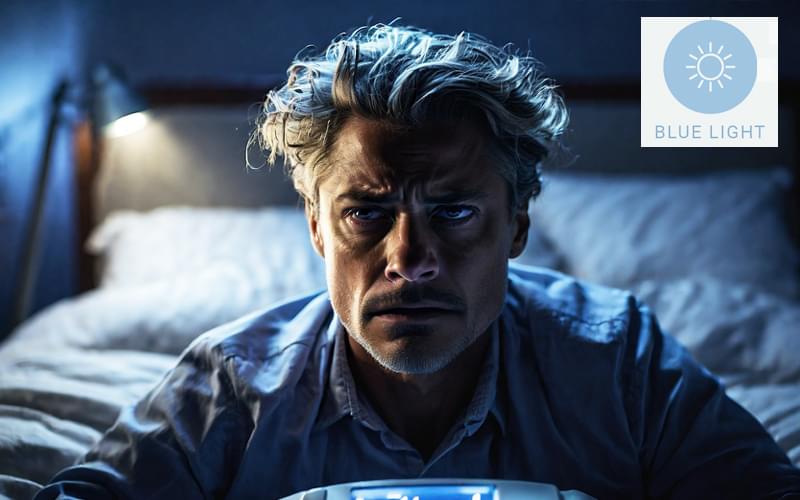
The circadian rhythm, a term that emerges from Latin words meaning "around" and "day," serves as the body's internal clock, orchestrating the ebb and flow of our sleep-wake cycles over a 24-hour period. This complex, yet finely tuned, biological clock is regulated by a specific area in the brain known as the suprachiasmatic nucleus (SCN), located in the hypothalamus. The SCN processes signals from the eyes, responding to the light and darkness in an individual's environment, thereby influencing sleep patterns, hormone release, body temperature, and other vital bodily functions.

The interplay between light exposure and the circadian rhythm is indispensable for optimal health. The cycle can be disturbed by irregular sleep patterns, shift work, or excessive exposure to light at night, particularly the blue light emitted by screens, which can impair melatonin production, a hormone that signals the body to prepare for sleep. Such disruptions can lead to a variety of sleep disorders, as well as other health complications, emphasizing the significance of synchronizing our internal clock with the natural world.
Understanding the mechanics of the circadian rhythm not only unveils the intricacies of sleep but also highlights its impact on our overall well-being. Researchers have found that maintaining a regular schedule that aligns with our circadian rhythm can improve mood, cognitive function, and metabolic health. It suggests that living in harmony with our internal biological clock, by waking up with the sun and winding down as it sets, might just be the cornerstone of good health.
The investigation into circadian rhythms has opened new avenues for understanding human biology. This ongoing research holds promise for the development of treatments tailored to the body's natural rhythms, offering hope for individuals suffering from sleep and circadian-related disorders. As we continue to unlock the secrets of the circadian rhythm, we edge closer to harnessing its potential to enhance human health and wellness.
| Concept | Description |
|---|---|
| Circadian Rhythm | The body's internal clock that regulates the sleep-wake cycle over a 24-hour period. |
| Suprachiasmatic Nucleus (SCN) | Area in the brain responsible for controlling circadian rhythms, located in the hypothalamus. |
| Melatonin | A hormone produced in response to darkness, promoting sleep and regulating the circadian rhythm. |
| Blue Light | Light with shorter wavelengths, often from electronic screens, that can disrupt the body’s preparation for sleep. |
Melatonin, often dubbed the "hormone of darkness," plays a critical role in our sleep-wake cycle, acting as a signal in our bodies to promote sleep. Produced in the pineal gland, its secretion is heavily influenced by light exposure, with levels naturally increasing after dark to help signal the body that it is time to rest. This inbuilt biological mechanism is paramount in understanding what is sleepiness and how our bodies regulate it. As night falls and melatonin levels rise, we experience a decrease in alertness and feel an increasing drive towards sleep, showcasing the hormone's pivotal role in preparing our body for rest.
The intricate relationship between melatonin and the circadian rhythm underscores its importance as nature's sleep regulator. Our circadian rhythm, or internal clock, orchestrates bodily functions including the sleep-wake cycle, and melatonin production is synchronized with this rhythm. Disturbances in melatonin secretion, whether due to artificial light exposure or lifestyle choices, can lead to disruptions in our circadian rhythm, thus impacting our quality of sleep. In today's digital age, the blue light emitted from screens is especially culpable in delaying melatonin release, making it harder to fall asleep and contributing to a broader discussion on sleep hygiene and health.
Scientific investigations into melatonin's effects have extended beyond mere sleep induction. Research has shown that melatonin possesses antioxidant properties, playing a role in immune function and even potentially offering protection against certain diseases. Its influence extends to regulating body temperature, blood pressure, and glucose levels, highlighting its multifaceted role in maintaining physiological homeostasis.
In conclusion, melatonin serves as an essential cog in the biological machinery that governs sleepiness and the sleep-wake cycle. Its regulation by light and inherent connection to our circadian rhythm exemplify the complex interplay between our environment and internal biological processes. As we continue to unravel the mysteries of sleep, melatonin’s role as nature's sleep regulator remains a vital area of study, promising to shed light on novel therapeutic avenues for sleep disorders and contribute to broader health and well-being strategies.

The intricate mechanisms governing our sleep-wake cycles hinge significantly on the influence of various light sources, notably the pervasive blue light. Emitted in large quantities by screens and LED lighting, blue light plays a pivotal role, impacting the production of melatonin, the hormone responsible for regulating sleep. Unlike natural light, which helps maintain our circadian rhythm in synchronization with the Earth's day-night cycle, blue light at night can trick the brain into delaying sleep onset, disrupting our natural sleep patterns.
Delving deeper, the science reveals that exposure to blue light suppresses melatonin production more effectively than other light forms. This suppression results in an altered perception of night and day, leading to difficulties in initiating and maintaining sleep. Thus, as we immerse ourselves in screen-based activities before bedtime, we inadvertently signal our brains that it is still day, which may contribute to the feeling commonly described as "what is sleepiness?" These actions set the stage for a delayed sleep phase syndrome, where the individual’s sleep schedule is pushed to a later time, affecting overall sleep quality.
Moreover, to mitigate the adverse effects of blue light, experts suggest leveraging technology to our advantage. Many devices now feature settings that reduce blue light exposure in the evening hours, substituting it with warmer tones that have minimal impact on melatonin production. Additionally, the adoption of amber-tinted glasses that block blue light can be an effective method for those who cannot avoid screen time before bed.
The conversation around light exposure and sleep extends beyond mere recognition of the issue. It encompasses a discussion on how modern life, with its emphasis on constant connectivity and late-night screen usage, necessitates a reassessment of our evening routines. Adopting practices that align more closely with our biological rhythms promises not only improved sleep quality but also a better understanding of the complex tapestry of factors that contribute to "what is sleepiness?" This knowledge empowers individuals to make informed decisions about their exposure to light, paving the way for healthier sleep patterns and, by extension, a healthier life.
In exploring the underpinnings of sleep science, adenosine emerges as a critical biochemical influencer, orchestrating the crescendo of sleepiness that envelops us. This naturally occurring nucleoside functions throughout the body, but its role in sleep regulation is particularly pivotal. With each waking moment, adenosine levels accumulate in the brain, a process propelled by neuronal activity. This accumulation is not arbitrary but serves as a physiological signal, heralding the need for rest. As adenosine concentrations rise, they bind to specific receptors in the brain, initiating a cascade of reactions that culminate in the sensation of sleepiness. This mechanism serves as a balance, ensuring that the longer we stay awake, the greater our need for sleep becomes, thereby promoting a regenerative cycle of wakefulness and rest.
Delving deeper into the molecular saga, adenosine's function is intricately linked with the homeostatic regulation of sleep pressure. This term refers to the body's propensity to sleep, which elevates as adenosine levels increase. Interestingly, the phenomenon of sleepiness is not merely a signal to the body to prepare for sleep but a physiological imperative that influences the quality and duration of sleep itself. Caffeine, a widely consumed stimulant, offers a compelling case study in adenosine's role. By blocking adenosine receptors, caffeine temporarily wards off feelings of sleepiness, illustrating the direct interplay between this molecule and sleep regulation.
However, adenosine's influence is not a solitary act but part of a comprehensive symphony involving other sleep-regulating mechanisms. Light exposure, melatonin production, and even psychological states interweave with adenosine's regulatory functions, highlighting the complexity of what is sleepiness. Recognizing adenosine's contribution not only enriches our understanding of the sleep process but also emphasizes the importance of maintaining a healthy balance. Ensuring adequate rest, managing caffeine intake, and understanding the factors that influence adenosine can improve sleep quality and, by extension, overall well-being. This exploration of adenosine's role offers a glimpse into the intricate biological processes that underlie the universal experience of sleepiness, underscoring the marvel that is the human body's regulatory capacity.

The intricate relationship between diet, exercise, and sleep is one woven with various biological threads, central among them being how these elements influence the circadian rhythm and neurochemical balances impacting what is sleepiness. Nutritional intake plays a pivotal role, where certain foods contain elements that can either promote sleepiness or contribute to alertness. For instance, carbohydrates, when consumed in moderation, can increase the level of tryptophan in the brain, thereby assisting in the production of melatonin, the hormone that regulates sleep. Conversely, foods high in sugar and caffeine can disrupt sleep patterns, delaying the onset of sleepiness.
Exercise, too, holds a significant sway over sleep quality and duration. Regular physical activity has been shown to deepen sleep cycles, making the sleep more restorative. This is partially attributed to the increase in body temperature that occurs during exercise, followed by a post-exercise drop in temperature, mirroring the natural drop in body temperature triggered by the circadian rhythm at night which signals the body that it's time to sleep. Moreover, engaging in regular exercise reduces stress and anxiety, which are often culprits behind sleep disturbances.
The synergy between diet and exercise further illuminates their impact on sleep. A balanced diet can enhance the effects of exercise by fueling the body with the right nutrients, thus optimizing energy use and recovery, which in turn facilitates a healthier sleep pattern. This interplay is supported by numerous studies indicating that individuals who maintain a balanced diet and regular exercise regimen tend to fall asleep faster and enjoy a more restful sleep.
Here's a table summarizing key points related to diet, exercise, and their effects on sleep:
| Aspect | Impact on Sleep |
|---|---|
| Nutrition | Foods high in tryptophan and carbohydrates can promote sleepiness by encouraging melatonin production, whereas high sugar and caffeine intake can disrupt sleep patterns. |
| Exercise | Regular physical activity deepens sleep cycles and reduces the time it takes to fall asleep by mimicking and enhancing natural physiological processes related to sleep. |
| Synergy | A balanced diet fuels the body for better performance during exercise, which in turn leads to more restorative sleep. |
| Psychological Benefits | Both diet and exercise have been shown to reduce stress and anxiety levels, which are often linked to sleep disturbances. |
Through understanding and optimizing our diet and exercise routines, we can significantly impact our sleep quality and overall well-being, thereby demystifying what is sleepiness and taking control over our sleep health.
The intricate web of psychological states profoundly impacts our sleep architecture, with stress and anxiety at the forefront of disrupting normal sleep patterns. Diving into the neuroscientific perspective, these emotions trigger the body's fight-or-flight response, a primordial mechanism that releases cortisol and adrenaline into our bloodstream. This hormonal surge is beneficial during daytime threats but detrimental at night when it elevates heart rate and mental alertness, antagonistically affecting our ability to transition into the calm required for sleep. Thus, the delicate balance of our internal sleep-wake cycle is compromised, leading to difficulties in initiating and maintaining sleep.
Exploring further, chronic stress complicates this scenario by perpetuating a state of hyperarousal. This condition extends the physiological and psychological arousal state, hampering the natural decline in body temperature essential for sleep onset. Consequently, individuals trapped in this cycle experience decreased sleep efficiency, characterized by frequent awakenings and altered sleep stages, particularly a reduction in restorative deep sleep and REM sleep. Such disruptions can exacerbate feelings of daytime sleepiness, ironically fueling anxiety about sleep itself, creating a vicious cycle that can be challenging to break.
Research also underscores the role of cognitive processes in stress-related sleep disturbances. Rumination and worry, common cognitive manifestations of anxiety, activate regions of the brain associated with emotion and problem-solving outside of conscious control. This mental activity during intended sleep hours can delay the onset of sleep by keeping the mind engaged and alert, further evidencing how intertwined our mental state is with our sleep health.
Acknowledging these challenges lays the groundwork for interventions aimed at mitigating the impact of stress and anxiety on sleep. Cognitive-behavioral therapy (CBT) and mindfulness practices have emerged as effective tools in breaking the cycle of sleep anxiety by retraining the brain’s response to stress and preparing the mind and body for rest. Developing a pre-sleep routine that includes relaxation techniques can also significantly enhance sleep quality, illustrating the power of psychological interventions in restoring harmonious sleep patterns.

270 Pine Mountain Rd Ste 5 Hudson NC 28638
(828) 757-8282